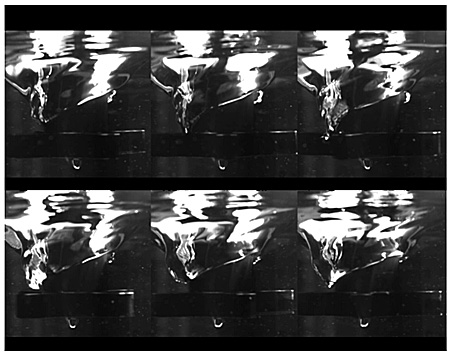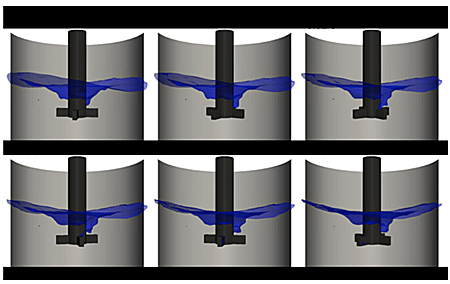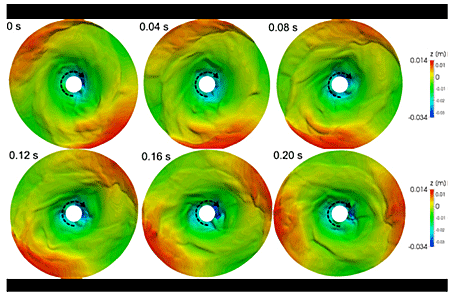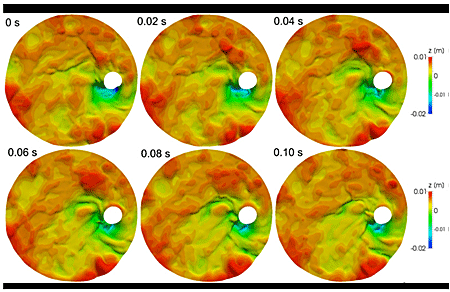Incorporation of fine particles into molten metal can be realized by loading the particles onto the free surface of molten metal bath agitated mechanically using impellers. In this case, a vortex is formed on the free surface which provides high-intense turbulent pulsations of the free surface causing incorporation of particles inti the molten bath. On the other hand, turbulent pulsations are undesirable because they may cause enhanced oxidation of aluminum and entrainment of the oxide films into the aluminum melt.
The present study investigated the mechanism of surface vortex formation and free surface deformation in an unbaffled stirred vessel with on-axis and eccentric impellers having four paddle blades. The impeller rotation speed was set to 300 and 400 r.p.m. To shed light on the mechanism of surface vortex formation and free surface deformation, we conducted experiments and numerical simulation in an unbaffled cylindrical stirred vessel. The surface vortex was found to be small in the eccentrically stirred vessel due to a vertical flow caused by the interaction between the discharged flow and sidewall. In the case of on-axis impeller, low-pressure zones at the rear faces of blades pulled the free surface down, that caused the air entrainment. These phenomena could be seen in both the experimental observation and numerical simulation. The three types of transient free surface deformation were observed: local vortex formation due to the low-pressure zone mentioned above, entire rotation of free-surface elevation due to the macro-instability, and local elevation and deflection due to trailing vortices.
Figures 1 and 2 show that when the rotation speed of on-axis impeller becomes as high as 400 r.p.m, the vortex free surface is deformed in such a way that its bottom part comes into contact with the upper part of the impeller blades causing air entrainment and oxidation of the melt surface in the case of real melting furnace. The air entrainment can be observed experimentally (Fig. 1) and predicted numerically (Fig. 2). The predicted vortex depth can determined from Fig. 3 depicting the time variation of the free surface shape around the shaft of the on-axis impeller. At rotation speed of 400 r.p.m the depth is approximately 0.035 m.
On the other hand, when the impeller was positioned eccentrically, no vortex formation was observed, and the free surface was deformed to a much smaller extent compared to the on-axis impeller case, as shown in Fig. 4. Instead, the free surface is covered with a large number of relatively small-scale crests and troughs varying dynamically in time. Detailed simulation revealed that such a behavior of the free surface is caused by trailing vortices generated near the impeller blades and transported by convection toward the free surface.
It is assumed that agitation of liquid bath with eccentrically positioned impeller is more preferable than the on-axis agitation, especially in the case where there is a need to incorporate fine particles into liquid bath. This will be the subject of our further investigation.



